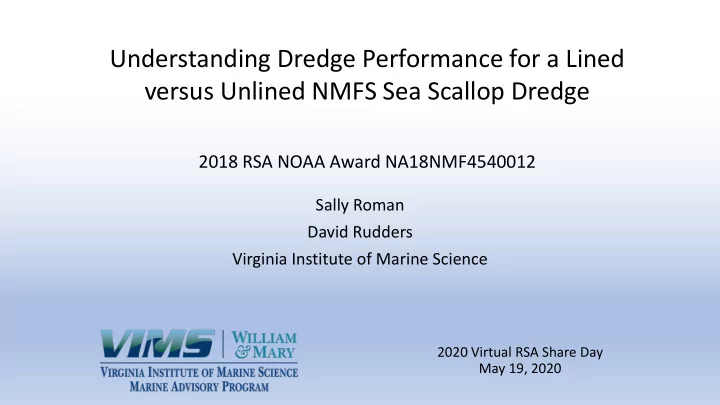

Understanding Dredge Performance for a Lined versus Unlined NMFS Sea Scallop Dredge 2018 RSA NOAA Award NA18NMF4540012 Sally Roman David Rudders Virginia Institute of Marine Science 2020 Virtual RSA Share Day May 19, 2020
Project Objectives • Main objective: • 2018 RSA Priority: Investigation of • Assess dredge performance variability in dredging efficiency with & without liner across habitats, times, areas and gear designs to improve dredge • Secondary objectives: survey estimates • Assess dredge performance for a range of survey • Divergent biomass estimates in ET protocols Flex, NL West & NL South Deep Tow speed SAMS Areas Scope to depth ratio • Assess performance with • Result of dredge saturation simulated catch
Project Overview • Scale survey dredge was tested at Memorial University Marine Institute’s flume tank • March 19-20, 2019 • Collaborators: • George Legge, Facilities Supervisor for the flume tank • Tor Bendiksen, Reidars Manufacturing
Project Overview • Test with and without liner • Scale survey dredge 1:6.65 model installed • Speeds tested: • 2 tow wire diameters tested • 3,3.5, 3.8, 4 & 4.5 kts • 4-4.5 kts at 0.1 kt intervals • Tested dredge under standard protocols • Scope to depth ratios tested: • 2.5:1, 3:1, 3.1:1, 3.25:1 & 3.5:1
Project Overview Dye tabs placed on dredge for hydrodynamic tests • Hydrodynamic tests • Simulated catch tests: 30, 100, 150 & 300 BioRings BioRing used in simulated catch • Pressure plate size test tests
Project Overview Location of dredge measurements • Warp tension (unit kilogram-force (kgf)) • Maximum bag height (mm) (A) • Height at the twine top end (mm) (B) Dredge angle measurement • Height of the wheel of bottom (mm) (C) • Wire angle (degrees) • Video for most tests • Dredge angle calculated from video still images (ImageJ)
Results – Liner vs No Liner Unlined Dredge Lined Dredge 3:1 Scope to Depth Ratio, 3.8 kts 3:1 Scope to Depth Ratio, 3.8 kts Dredge had a better overall shape based on the opinion of the individuals at the trials, as well as measurements of the bag and twine top height. Dredge angle did not difference greatly between the lined and unlined dredge configurations.
Results – Liner vs No Liner Unlined Dredge Lined Dredge 3:1 Scope to Depth Ratio, 3.8 kts & 100 BioRings 3:1 Scope to Depth Ratio, 3.8 kts & 100 BioRings Hydrodynamic flow was also improved when the liner was installed in the dredge.
Results – Simulated Catch Dredge Angle • Catch volume & speed can impact dredge angle • At 3.8-4 kts dredge angle was similar • For VIMS survey, dredge angle began to increase at 4.3 kts with 100 BioRings
Results – Simulated Catch Wheel Height • Catch volume & speed increased the height of the wheel off the conveyor belt • Wheel height off bottom was greatest at largest catch volume
Results – Dredge Angle Lined dredge, 3:1 Scope to Depth Ratio, 3.8 kts Dredge angle: 5.4° Lined dredge, 3:1 Scope to Depth Ratio, 4 kts Dredge angle: 5.3°
Discussion • Flume tank project allowed for dredge to be studied under controlled conditions • Does not account for real world conditions including environmental conditions, substrate type or extreme catch volumes • Liner does not seem to negatively effect dredge performance • Catch volume & tow speed can increase dredge angle, wheel height, twine top height and height of dredge bag • Reduced efficiency may be a combination of gear saturation and decreased dredge performance
Discussion • Optimal dredge angle/fishing configuration? • Unaware of any protocols for optimal dredge angle for survey dredge • Under current protocols the VIMS dredge shoes & wheel are completely on the conveyor belt • Should dredge be fished differently? • VIMS tow speed could be increased • May not be needed for NEFSC survey
Recommend
More recommend